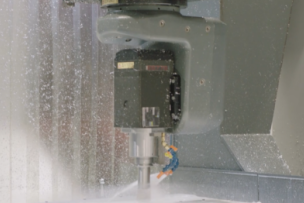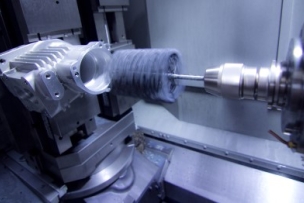Headquartered in Aurora, IL, Mitutoyo America Corporation is the world's largest provider of measurement and inspection solutions offering the most complete selection of machines, sensors, systems and services with a line encompassing CMM (coordinate measuring machines), vision, form and finish measuring machines, as well as precision tools and instruments, and metrology data management software. Mitutoyo's nationwide network of Metrology Centers and support operations provides application, calibration, service, repair and educational programs to ensure that our 8,500+ metrology products will deliver measurement solutions for our customers throughout their lifetime.
By Gene Hancz, Product Specialist, CMM, Mitutoyo America Corporation
When it comes to quality control, the biggest obstacle for aerospace manufacturing has been the fact that many are programming from a CAD model versus using automated tools to erase ambiguity when it comes to deciphering tolerancing, features and characteristics.
Utilizing PMI (Product Manufacturing Information) in the model is where design intent is derived. However, an overabundance of suppliers still do not use a CAD model or CAD with PMI to program inspection tools. This leaves the door open for mistyping and misinterpretation.
The PMI Barrier
One of the greatest reasons more aerospace manufacturers haven’t embraced PMI is the relatively high cost related to updating software or purchasing software to automate the process. This expense is twofold: many different CAD companies exist and, in turn, make their own CAD creation software.
And while CAD is an open architecture in a public domain, the reality is that you still must rely on the original CAD company for export. This lack of PMI adoption contributes to continued embracing of CAD models for measurement equipment programming, despite entities like NIST working to overcome adoption hurdles. But ultimately, the onus is on the aerospace supplier to decide what tools will be used, how data will be transferred into the system, and how needed features and characteristics will be supported.
A secondary issue in the industry is that there are only a few top software leaders for the creation of CAD model design in the U.S. These leaders are reluctant, for good reason, to allow their programs to be exported in a common neutral file that can be used in other forms of measurement like EMF or laser systems. Instead, they prefer to sell their CAD software. This software has become the norm in the aerospace industry.
So, even if the software might be harder to learn, it is what most engineers working in the industry understand how to use and are familiar with. And large aerospace companies typically use the software from the leading providers, given these providers were the first ones to come out with most of features that aerospace manufacturing required.
Overcoming Challenges to Embrace Digital
To mitigate quality inconsistencies for aerospace given the multiple providers, ideally developers of measuring equipment will take the different software offerings into account and ensure they can support all versions.
But realistically, we still run into the issue of certain tolerance characteristics being unsupported or being supported in the CAD model but not the PMI information. For example, certain software cannot read a graphical picture. The data within the PMI file needs to be manually added using other software tools, leading to a significant inconsistency in what is supported on the PMI part of the equation.
While tolerancing characteristic information in a CAD model isn’t always required, when it comes to inspection that data is needed. This is where the industry has fallen behind. If you were to ask CAD vendors and measuring companies using their software “how much inspection data do you support?”, you might find it's barely 50 to 60 percent.
In order to close the data support gap, the ANSI committee is currently considering revamping the GD&T system to eliminate 80 percent of current tolerances in favor of profile and position tolerancing for everything. This recommendation is part of a larger debate, given it would have serious development implications in terms of scrapping composite tolerancing and replacing it with surface profile.
The biggest problem with the way GD&T tolerances are now set up is how easily they are subject to interpretation by different engineers, so that many engineers fail to correctly indicate them on a print. This creates a significant problem, given that when CAD tools were built, error checking around GD&T tolerancing was not included.
If you’re a major aerospace company and you’re creating a new aircraft, you want one thing you can rely on as the bible for each particular part. And you want to be able to give that to anybody who will be manufacturing components or entire assemblies. In effect, that’s what this electronic data is. If you’re a manufacturer who tells an aerospace company you don’t work with CAD models, and thus need a blueprint, you won’t be hired. Digital is the future.
Where the Shift Begins
It really starts with the aerospace companies who first spent their dollars on CAD systems to develop parts, and then measuring equipment to check the accuracy of parts. Why wouldn't they want to have the same tool for inspection as for everything else? So, the CAD model with the correct information in it for inspection can generate an inspection program automatically.
With today’s digital technology, that means what previously required three hours using a paper print could actually take a minute or less—open up a model, read all the information, determine with the machine we’ve configured how to measure it, where to take points, what order to make it as fast as possible, identify all the datums needed, then with the single click of a button generate the part program. That’s time and money savings, a significant ROI, and a significant reduction in errors.
Modern technology even allows you to dictate measurement strategy based on a feature size. For example, the diameter could be half an inch, and you can set up a rule for anything a half inch or smaller. Or you could dictate that you want 37 points on everything, or 23, or the number that suits your needs. The ability to set up rules based on the feature itself goes a long way toward improving consistency and accuracy. This is especially important for streamlining the process, given companies look closely at how much time they're spending on CMM part programming versus measuring. Machine tools were once programmed at the machine. However, with the advent of CAM software this process became a digital plan uploaded to the machine tool. This increased the amount of time to produce more parts, where inspection equipment programming can be more efficiently planned, more accurate and more consistent using a digital CAD model with PMI. This will reap the same rewards as a machine tool, with less time programming parts on the CMM and more parts being inspected.
Key Digital Technology Takeaways for the Aerospace Industry
When it comes to measurement automation in the aerospace industry, there are ultimately three key takeaways to highlight:
- Cost savings. Automation streamlines and accelerates the process, while at the same time eliminating human error that can lead to costly scrap and delays.
- Commonality. Today’s automated programs are created the same way, meaning you’re able to use the same set of tools for determining how to measure a part. There is no operator influence on the development of the program.
- Cloud-based repository. Digital tools allow you to reduce your data storage footprint and allow you to easily review and access measurement data. You can see what you checked, when you checked it and what the environment of the measuring equipment was when you checked it (e.g., a 95-degree day vs. a 63-degree day) to see what influenced the measurement.
In the aerospace industry, accuracy is critical. Parts being produced ultimately impact safety and people’s lives. While there are significant checks and balances companies perform, especially around the creation of prototype parts, to catch anomalies, automation can add another layer of reassurance and remove the possibility that a mistyped input for diameter or tolerance by a CMM operator could lead to issues down the line.








Talk to Us!
Leave a reply
Your email address will not be published. Required fields are marked *